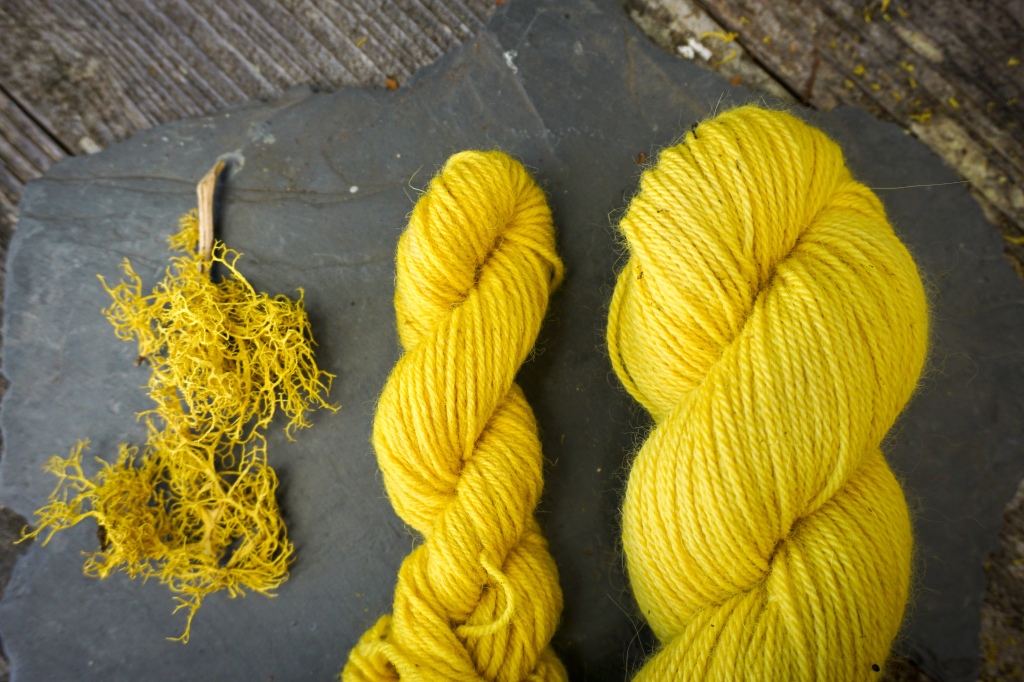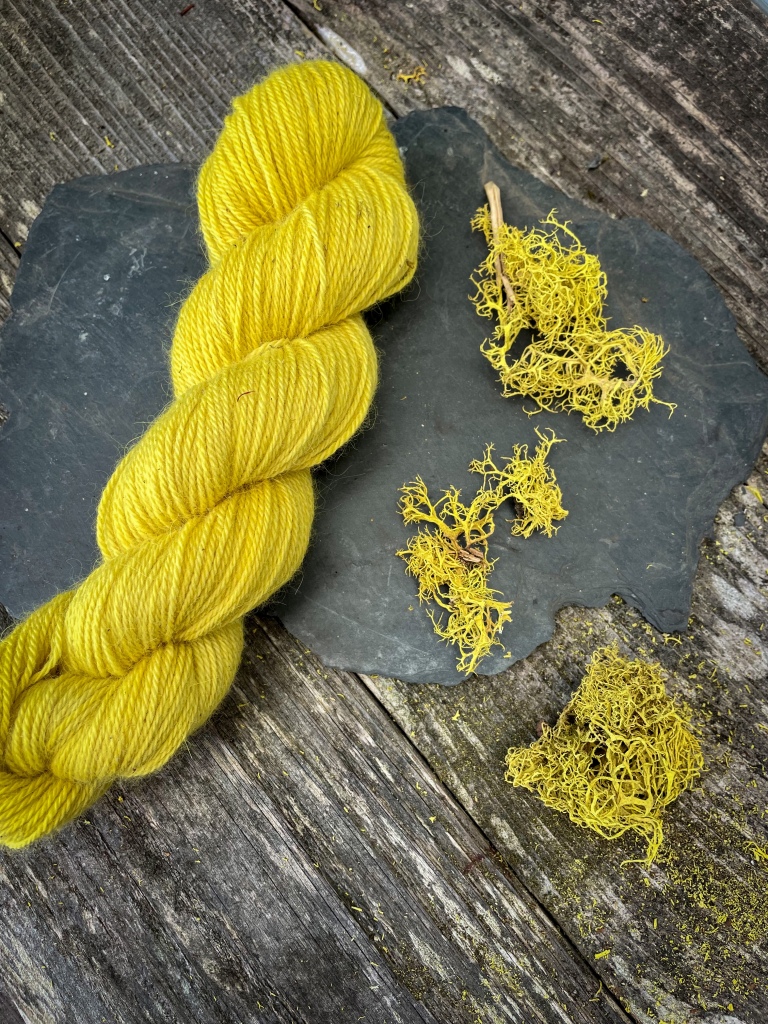My brother and I are working on a special monthslong video project focused on my Mom and the story behind her role in creating the first mushroom dye book, written by Miriam Rice. While telling us her story for the video, she pulled out her collection of dried lichens. She first dyed with lichens in the 1960’s while living in San Francisco, and mentioned wanting to revisit this dye process again more than 50 years later. Since I’ve never dyed with lichens, my brother and I seized on the idea to create our first lichen dye video – with Mom running the show. She agreed; she’s usually game for the ideas her kids conjure up.
She picked Wolf lichen because of its straight-forward dye process. I grabbed my hot plate and a sample skein of wool, she pulled out her trusty little dye pot, a bag of lichen, and showed me how it’s done.

Wolf lichen (Letharia vulpina) are typically found on conifers. This collection came from the Sierra Nevada here in California. It’s been historically used as a dye by Native Americans here in California as well as across the pond in Europe. No mention of lichen dye can go without a very important disclaimer: never collect directly from the tree – only use what has already fallen to the ground. In general, while lichens are still attached to a tree (or rock) they are growing and for some species, that can take years. Please respect the ecosystem.
My Mom goes over this lichen, where to collect it, and the dye process in our video:
A few months after we finished this video, I thought it would be fun to recreate the dye on my own, using the video as my only reference. This is how it went.
She gave me 5.8 ounces (101 grams) of dried Wolf lichen, so that I’d have enough dye stuff to dye 100g of fiber using her recommended 1:1 ratio. I used two 50 g skeins of unmordanted animal fiber: 75% wool/ 25% angora.
Following her instructions, I added the 101g of lichen into a large jar, pulling out as much debris as possible. I filled the jar with water and let it sit overnight.
The following afternoon, I poured the mixture into a dye pot (stainless steel), added more water to help my skeins move freely, and added healthy dollops of vinegar to create an acidic bath of pH4.
My new hot plate could not bring my dye to a simmer. Frustrated, I turned everything off for the night. The following morning, I brought the dye inside and onto my gas stove, quickly got it to a simmer for a period of time that I didn’t document, then moved it back outside and onto the hot plate, which had enough power to keep it at a simmer, thankfully. (Also opened all windows to air out my kitchen before the teenagers got up and complained about the sharp vinegary, woody smell in the house.)
I added one 50 g skein at a time, presoaked in hot water. I let it simmer with the lichen for another length of time that I didn’t keep track of because I dye while doing many other things simultaneously and pulled the skein out when I thought the yellow was bright enough. Then I added the second skein and repeated the process.

Once both skeins were rinsed, dried, and most of those little lichen bits shaken from the fiber strands, I brought them over to my Mom’s house and we compared them to the skein we dyed in the video.

It may be hard to tell in this photo, but in real life, my skeins aren’t as electric yellow as the one she created in the video. We had a few ideas as to why:
>She’s a better dyer (that was my idea).
>She used 100% wool whereas mine included 25% angora, so perhaps that fiber absorbed the dye differently. (This was my first time dyeing with angora, so I have nothing to compare it to).
>She also may have kept the skein in the dye longer because she actually measured her time instead of winging it like me.
Creating this large video project with my brother reminded me how meticulous my Mom documented all her dye experiments. Her dye notebooks are a mix of scientific observation, detailed measurements, and works of art. My notes are scribbles of the basics. Both methods work. So even if you’re like me, a little slap-dash, a little scattered because you’re spinning several plates in the air while the dye pot is simmering, it’s okay. You can still extract fantastic dye from this lichen.




Hi Myra!
Very nice post….great color and well done as usual! The only thing that got me thinking, was about the use of the lichen by Native Americans in California… I’m unsure that it was used by them in California, but I remember that the lichen was used for dyeing mountain goat wool to weave the Chilkat blankets by the Tlingit (and others?) in the Pacific Northwest and Alaska… I’m going to have get out my books and do some more research! I do not think that the California Native Americans wove with any wool, and I have not read about this lichen being used to dye any basketry materials… As always you inspire me to do more research!
Love, Mom
Well, your commentary got me to thinking, Myra! I only used my older dye books for reference, so I went back and checked in the newer “Lichens of California” by Mason E. Hale Jr & Mariette Cole, and sure enough right in the introduction (on page 4), they mention that “Wolf lichen” was used by the Klamath Indians to dye porcupine quills a beautiful canary yellow and these were woven into their baskets!!! So thanks for inspiring me to go back and learn something new with the lichens! Now, I would really like to see if we can do a solar dye with them on wool or silk in our hot Cotati summer sunshine!!!
Thanks Mom for once again being so thorough!
Hi Myra and Dorothy and the elusive (to me) Martin~
Wonderful videos, so fun for me to re-live those times of dyeing at home.
A correction for your subtitles—“dyeing” please (not “dying”).
Best wishes and hugs~ Susan Maresco
Bonjour Myra,
Je m’appelle Sibil Képéklian. Je suis en France et j’expérimente en teinture tout ce qui ma passe sous la main et surtout les champignons. Difficile mais fascinant.
Je viens de tomber sur votre site internet et je suis en joie ! Je suis conservatrice-restauratrice d’objets d’art spécialisé en objets ethnographiques et la teinture naturelle m’a toujours fasciné. J’ai rédigé un mémoire sur la teinture des piquants de porc-épic après avoir passé 6 mois au musée canadien des civilisations. C’était il y a dix ans. Après beaucoup de péripéties professionnelles, je retourne à mes amours d’antant. Bref, assez parlé de moi ! Je voulais juste vous dire que vous comblez deux de mes souhaits les plus sincères : documenter par la vidéo des procédés de teinture et surtout documenter et enregistrer le savoir de nos aïeules avant qu’il ne disparaisse.
Un grand merci. Je sens que je vais passer des heures et des heures à dévorer votre contenu. J’ai partager votre site internet sur le groupe facebook : Mushroom and Lichen Dyers United. Vous devez surement le connaitre.
Bonjour Sibil! Merci beaucoup!